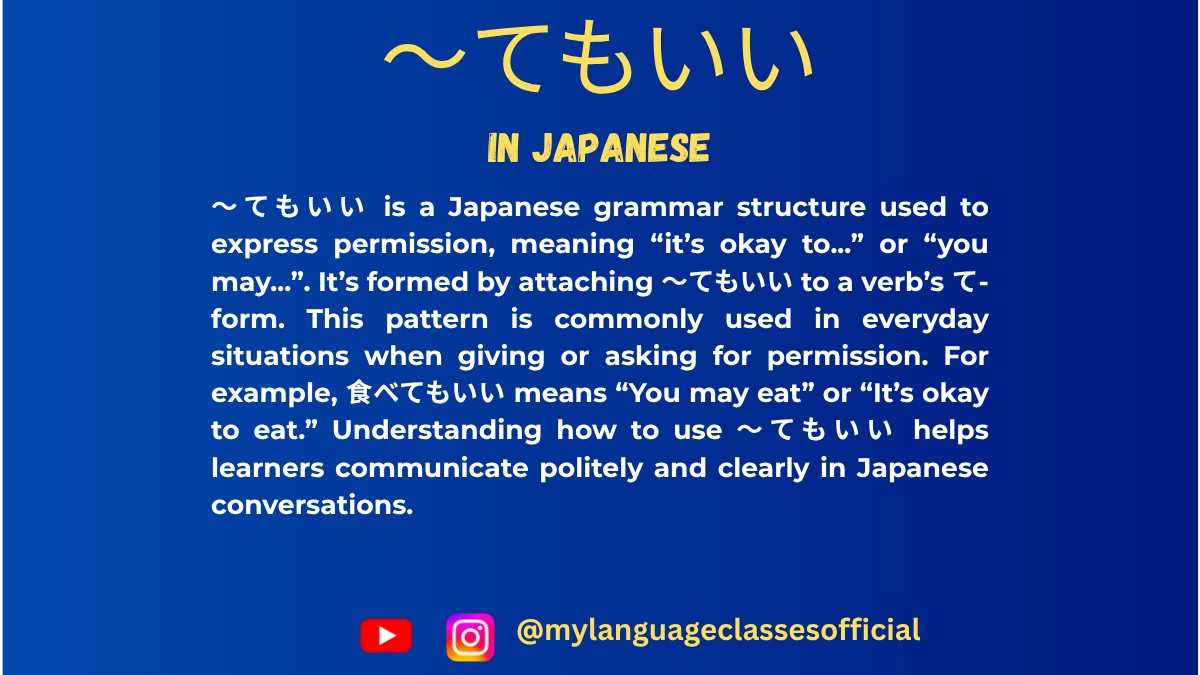Your cart is currently empty!
Tag: Japanese sentence structure
-
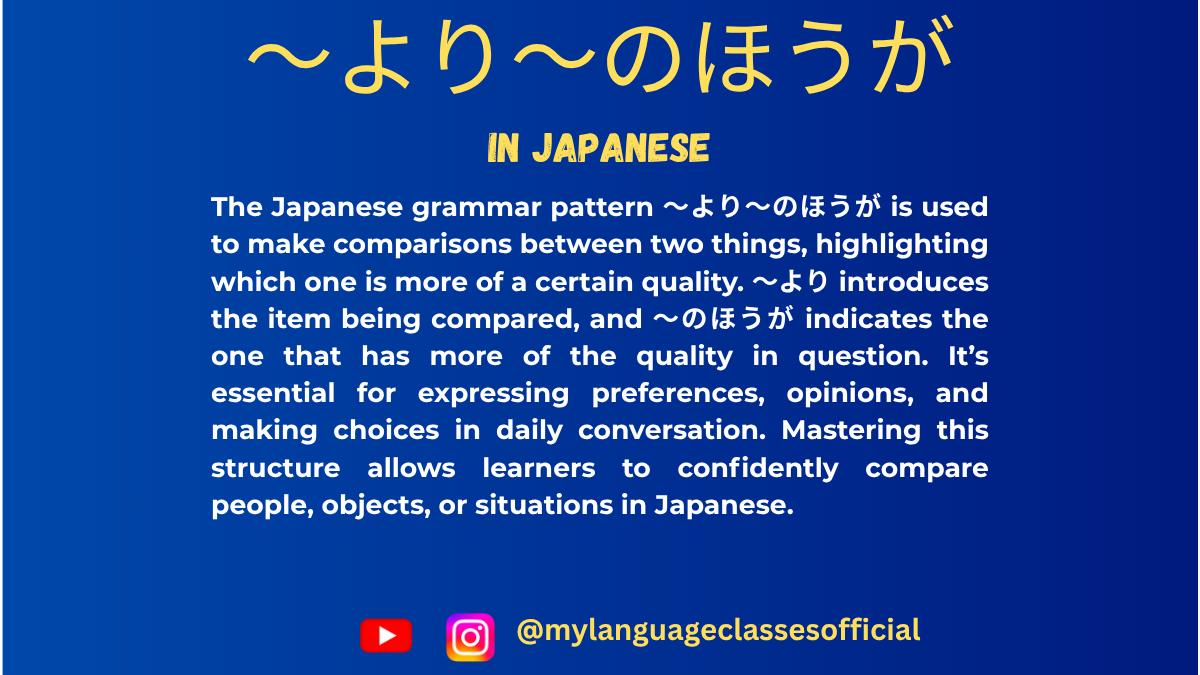
Understanding 〜より〜のほうが in Japanese | My Language Classes
Understanding 〜より〜のほうが
The construction 〜より〜のほうが is an essential tool in Japanese for making comparisons. It translates to “X is more than Y” or “X is better/more suitable than Y” and is widely used in everyday conversations, formal contexts, and written communication. This blog post dives into its meaning, usage, and various scenarios.
Structure of 〜より〜のほうが
The pattern is straightforward:
- Yより Xのほうが adjective/descriptive phrase.
- Yより: Indicates the thing being compared (Y).
- Xのほうが: Highlights the preferred or superior item (X).
Example:
- 犬より猫のほうが好きです。
(I like cats more than dogs.)
Core Uses of 〜より〜のほうが
- Preference
When expressing a preference between two items, activities, or options:- 旅行より勉強のほうが楽しいです。
(Studying is more fun than traveling.)
- 旅行より勉強のほうが楽しいです。
- Quantitative Comparisons
Highlighting differences in measurable qualities like size, speed, or price:- バスより電車のほうが早いです。
(Trains are faster than buses.) - このレストランよりあのレストランのほうが安いです。
(That restaurant is cheaper than this one.)
- バスより電車のほうが早いです。
- Capabilities
Used to compare abilities or skills:- 英語より日本語のほうが得意です。
(I’m better at Japanese than English.)
- 英語より日本語のほうが得意です。
- Frequency or Intensity
Comparing how often or how strongly something occurs:- 冬より夏のほうが好きです。
(I like summer more than winter.)
- 冬より夏のほうが好きです。
- Hypotheticals
For discussing hypothetical preferences or outcomes:- 映画館より家で映画を見たほうがいいです。
(Watching a movie at home is better than going to the cinema.)
- 映画館より家で映画を見たほうがいいです。
- Suitability
Indicating one option is more suitable for a specific purpose:- この仕事には男性より女性のほうが適しています。
(For this job, women are more suitable than men.)
- この仕事には男性より女性のほうが適しています。
Situations Where 〜より〜のほうが is Used
- Daily Conversations
- Comparing food, hobbies, weather, or locations:
- 寿司よりラーメンのほうがおいしいと思います。
(I think ramen is tastier than sushi.)
- 寿司よりラーメンのほうがおいしいと思います。
- Comparing food, hobbies, weather, or locations:
- Business and Professional Settings
- Discussing product qualities or work efficiency:
- この方法よりその方法のほうが効率的です。
(That method is more efficient than this one.)
- この方法よりその方法のほうが効率的です。
- Discussing product qualities or work efficiency:
- Travel and Leisure
- Comparing destinations, travel modes, or activities:
- 海外旅行より国内旅行のほうが安心です。
(Domestic travel is safer than international travel.)
- 海外旅行より国内旅行のほうが安心です。
- Comparing destinations, travel modes, or activities:
- Education and Learning
- Comparing subjects or teaching methods:
- 自習より先生に教えてもらうほうがいいです。
(Being taught by a teacher is better than self-study.)
- 自習より先生に教えてもらうほうがいいです。
- Comparing subjects or teaching methods:
- Relationships and Social Scenarios
- Evaluating people or interpersonal qualities:
- 彼より彼女のほうが優しいです。
(She is kinder than him.)
- 彼より彼女のほうが優しいです。
- Evaluating people or interpersonal qualities:
Key Notes
- Implied Context:
In conversational Japanese, the context often allows for the omission of repetitive elements:- 映画よりドラマのほうが好きです。(I like dramas more than movies.)
Can be shortened to:- ドラマのほうが好きです。 (I like dramas more.)
- 映画よりドラマのほうが好きです。(I like dramas more than movies.)
- Neutrality:
The phrase is neutral and doesn’t carry judgmental connotations, making it versatile for all scenarios. - Politeness Levels:
Depending on the situation, you can adjust politeness levels:- Casual: 〜より〜のほうがいい。
- Polite: 〜より〜のほうがいいです。
- Formal: 〜より〜のほうが適切です。
Practice Examples
- 自転車より車のほうが速いです。
(Cars are faster than bicycles.) - テレビを見るより本を読むほうがいいです。
(Reading books is better than watching TV.) - 東京より大阪のほうが住みやすいと思います。
(I think Osaka is easier to live in than Tokyo.)
By mastering 〜より〜のほうが, you can convey nuanced preferences and comparisons effectively. Practice using it in different contexts to build fluency!
What comparisons will you try making today? Let me know in the comments!
If you enjoyed this lesson, be sure to check out more posts like this on my blog at My Language Classes. Don’t forget to subscribe my YouTube channel and follow me on Instagram for the latest language learning tips and lessons. Leave a comment below to share your thoughts, or ask any questions you have about nouns.
Happy learning! 😊
- Yより Xのほうが adjective/descriptive phrase.
-

Understanding “〜てはいけない” in Japanese | My Language Classes
How to Use 〜てはいけない
The phrase “〜てはいけない” is a common Japanese grammatical structure used to express prohibition, or things that are not allowed. It translates to “must not” or “cannot” in English. This phrase is widely used in various contexts, from giving instructions to setting rules.
Formation of 〜てはいけない
The structure “〜てはいけない” is formed by attaching て-form of a verb to はいけない. Here’s how it works:
- Convert the verb to its て-form.
- Add はいけない to the end of the verb.
Example:
- 食べる (to eat) → 食べてはいけない (must not eat)
- 行く (to go) → 行ってはいけない (must not go)
Situations Where “〜てはいけない” is Used
- Rules and Regulations
Used to express prohibitions in formal and informal rules:- 学校で携帯電話を使ってはいけない。
(You must not use mobile phones at school.) - ここでタバコを吸ってはいけません。
(You must not smoke here.)
- 学校で携帯電話を使ってはいけない。
- Giving Orders or Instructions
Often used in scenarios where instructions need to be clear:- 試験中に話してはいけない。
(You must not talk during the exam.) - このドアを開けてはいけません。
(You must not open this door.)
- 試験中に話してはいけない。
- Moral or Ethical Prohibitions
Refers to socially unacceptable behaviors:- 他人のものを勝手に使ってはいけない。
(You must not use someone else’s belongings without permission.) - 嘘をついてはいけません。
(You must not lie.)
- 他人のものを勝手に使ってはいけない。
- Safety Warnings
Used to highlight actions that could lead to danger:- この薬を飲んでお酒を飲んではいけません。
(You must not drink alcohol after taking this medicine.) - 火のそばで遊んではいけない。
(You must not play near fire.)
- この薬を飲んでお酒を飲んではいけません。
- Expressing Social Norms
Indicates socially expected behaviors or taboos:- ご飯を食べながらしゃべってはいけません。
(You must not talk while eating.)
- ご飯を食べながらしゃべってはいけません。
- Parent-Child or Teacher-Student Scenarios
Frequently used in educational or authoritative contexts:- 遅くまでテレビを見てはいけない。
(You must not watch TV until late.) - 宿題を忘れてはいけません。
(You must not forget your homework.)
- 遅くまでテレビを見てはいけない。
Points to Remember
- Polite Variations
In formal or polite speech, いけない can be replaced with いけません:- ここに入ってはいけません。
(You must not enter here.)
- ここに入ってはいけません。
- Casual Variations
In casual speech, てはいけない may become ちゃいけない or じゃいけない:- そんなことしちゃいけないよ!
(You shouldn’t do that!)
- そんなことしちゃいけないよ!
- Cultural Context
Understanding when to use “〜てはいけない” depends on the context. Japanese culture often emphasizes politeness and indirectness. Therefore, use polite forms in formal settings to avoid sounding harsh.
Examples of Verbs and Usage
Verb (Dictionary Form) て-Form Usage Example 飲む (to drink) 飲んで お酒を飲んではいけない。(You must not drink alcohol.) 遊ぶ (to play) 遊んで 道路で遊んではいけない。(You must not play on the road.) 書く (to write) 書いて 壁に書いてはいけません。(You must not write on the wall.) 行く (to go) 行って 危険な場所に行ってはいけない。(You must not go to dangerous places.) 話す (to talk) 話して 授業中に話してはいけません。(You must not talk during class.)
List of Situations for “〜てはいけない”
- At school (e.g., no phones, no talking during tests)
- At work (e.g., no eating at desks, no accessing unauthorized files)
- Public spaces (e.g., no littering, no smoking in non-smoking zones)
- During social interactions (e.g., no interrupting others, no offensive comments)
- While driving (e.g., no using phones, no speeding)
- At home (e.g., no playing with dangerous tools, no staying up too late)
- With safety rules (e.g., no entering restricted areas, no consuming certain substances)
By understanding and mastering the use of “〜てはいけない,” you can effectively communicate prohibitions and rules in Japanese. This structure is crucial for clear, polite, and culturally appropriate expressions in both written and spoken Japanese.
If you enjoyed this lesson, be sure to check out more posts like this on my blog at My Language Classes. Don’t forget to subscribe my YouTube channel and follow me on Instagram for the latest language learning tips and lessons. Leave a comment below to share your thoughts, or ask any questions you have about nouns.
Happy learning! 😊
-
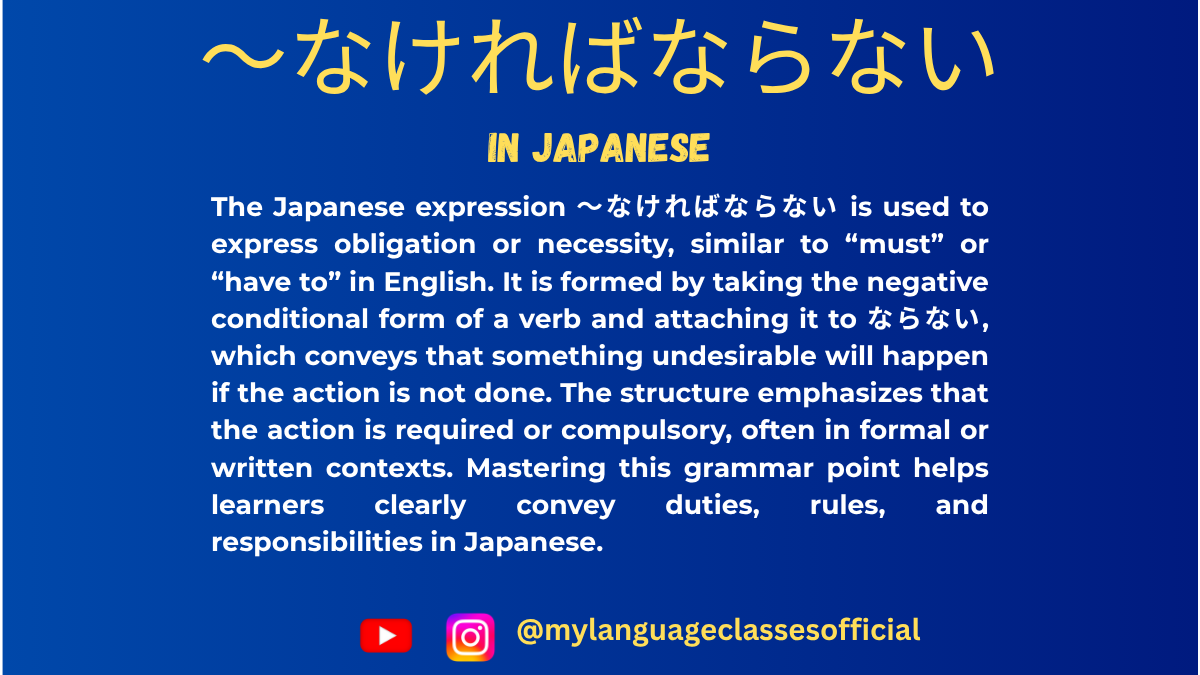
Understanding 〜なければならない in Japanese | My Language Classes
How to Use 〜なければならないin Japanese
The phrase 〜なければならない is a commonly used Japanese grammar structure that expresses obligation or necessity, similar to “must” or “have to” in English. It’s essential for learners to master this phrase because it is frequently used in both formal and casual settings.
Structure of 〜なければならない
- Verb in the Negative Form + なければならない
- Example: 行く → 行かなければならない
(iku → ikanakereba naranai)- Meaning: “I must go.”
- Example: 行く → 行かなければならない
- Conjugation Steps:
- Take the negative form of the verb (ない form).
- Replace ない with なければならない.
Variations of 〜なければならない
- 〜なければいけない
- Another common form with the same meaning.
- Slightly softer in tone.
- 〜なくてはならない
- Less commonly used in casual conversation but often appears in written or formal contexts.
- 〜なくてはいけない
- Similar to 〜なければいけない and used in formal or polite speech.
Situations Where 〜なければならない is Used
Here’s a list of situations where this grammar is appropriate:
1. Rules and Regulations
- Expressing obligations based on rules or laws.
- Example:
- 学校に行かなければならない。
(Gakkou ni ikanakereba naranai.)- Meaning: “I must go to school.”
- 学校に行かなければならない。
2. Work and Responsibilities
- Talking about duties or tasks that must be completed.
- Example:
- 仕事を終わらせなければならない。
(Shigoto o owarasena kereba naranai.)- Meaning: “I must finish the work.”
- 仕事を終わらせなければならない。
3. Social and Cultural Expectations
- Highlighting social norms or obligations.
- Example:
- 礼儀を守らなければならない。
(Reigi o mamorana kereba naranai.)- Meaning: “I must observe proper manners.”
- 礼儀を守らなければならない。
4. Personal Commitments
- Expressing personal resolutions or goals.
- Example:
- ダイエットのために運動しなければならない。
(Daietto no tame ni undou shinakereba naranai.)- Meaning: “I must exercise for my diet.”
- ダイエットのために運動しなければならない。
5. Health and Safety
- Discussing health-related necessities.
- Example:
- 健康のために野菜を食べなければならない。
(Kenkou no tame ni yasai o tabena kereba naranai.)- Meaning: “I must eat vegetables for my health.”
- 健康のために野菜を食べなければならない。
6. Moral or Ethical Obligations
- Talking about what is morally right.
- Example:
- 嘘をついてはいけないし、謝らなければならない。
(Uso o tsuite wa ikenai shi, ayamaranakereba naranai.)- Meaning: “I must not lie, and I must apologize.”
- 嘘をついてはいけないし、謝らなければならない。
7. Deadlines and Time-Sensitive Tasks
- When tasks need to be completed by a specific time.
- Example:
- 今週末までにレポートを提出しなければならない。
(Konshuumatsu made ni repooto o teishutsu shinakereba naranai.)- Meaning: “I must submit the report by this weekend.”
- 今週末までにレポートを提出しなければならない。
Key Points to Remember
- Formality:
- 〜なければならない is slightly more formal than 〜なければいけない. Use it in professional or formal writing.
- Alternative Expressions:
- In casual settings, people often shorten the phrase to 〜なきゃ or 〜なくちゃ.
- Example: 勉強しなきゃいけない (Benkyou shinakya ikenai) = “I must study.”
- In casual settings, people often shorten the phrase to 〜なきゃ or 〜なくちゃ.
- Cultural Context:
- Japanese culture values politeness and rules, so this structure is vital for expressing respect towards societal norms.
- Flexibility:
- While the grammar indicates obligation, tone and context can soften its intensity. For example, “You must” may sound harsh in English, but in Japanese, it’s often a gentle reminder or encouragement.
Practice Exercises
- Convert the following sentences into 〜なければならない form:
- 私は毎日運動する。
- 宿題をする。
- 早く起きる。
- Translate into Japanese:
- I must visit the doctor tomorrow.
- We have to clean the house by this evening.
- Imagine you are living in Japan. Write three sentences about what you “must” do in daily life using 〜なければならない.
Mastering 〜なければならない is crucial for understanding how to express obligations in Japanese effectively. Start using it in your conversations and writing to become more natural and fluent!
If you enjoyed this lesson, be sure to check out more posts like this on my blog at My Language Classes. Don’t forget to subscribe my YouTube channel and follow me on Instagram for the latest language learning tips and lessons. Leave a comment below to share your thoughts, or ask any questions you have about nouns.
Happy learning! 😊
- Verb in the Negative Form + なければならない
-
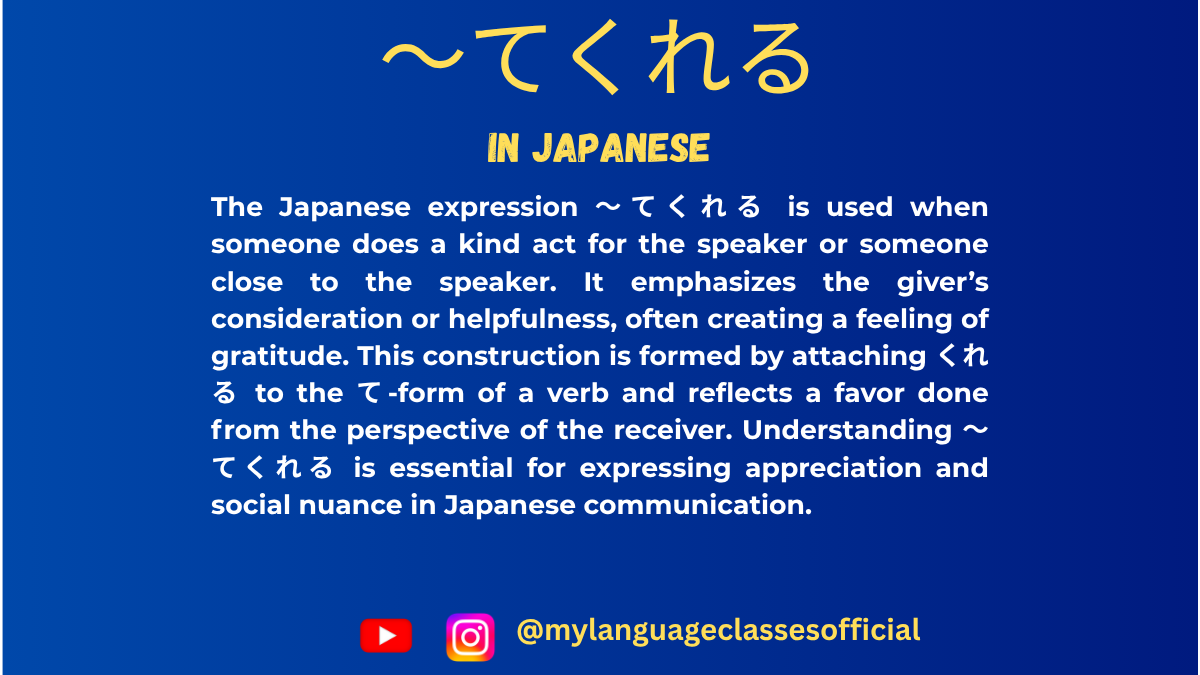
How to Use 〜てくれる | My Language Classes
Understanding “〜てくれる” in Japanese
The Japanese expression 〜てくれる is a key grammatical structure used to describe actions done for the speaker’s benefit or someone close to them. It conveys gratitude and appreciation towards the doer. Let’s explore its usage in various contexts and provide a list of situations where “〜てくれる” is used.
What is 〜てくれる?
“〜てくれる” is derived from the verb くれる, which means “to give.” When attached to the て-form of a verb, it expresses that someone performs an action for the speaker (or someone in the speaker’s inner circle). It implies a sense of appreciation and goodwill.
- Structure:
[Person] が [Verb (て-form)] くれる
(Someone does something for me or someone in my group.) - Example:
- 友達が宿題を手伝ってくれた。
(Tomodachi ga shukudai o tetsudatte kureta.)
→ “My friend helped me with my homework.” - 先生が日本語を教えてくれました。
(Sensei ga Nihongo o oshiete kuremashita.)
→ “The teacher kindly taught me Japanese.”
- 友達が宿題を手伝ってくれた。
Situations Where 〜てくれる is Used
1. When Someone Helps You
Used when someone provides assistance that benefits the speaker.
- Example:
- 兄が荷物を運んでくれた。 (Ani ga nimotsu o hakonde kureta.)
→ “My older brother carried my luggage for me.”
- 兄が荷物を運んでくれた。 (Ani ga nimotsu o hakonde kureta.)
2. When Someone Gives You Something
Used when someone gives you an object (related to くれる itself).
- Example:
- 友達がプレゼントを買ってくれた。 (Tomodachi ga purezento o katte kureta.)
→ “My friend bought me a present.”
- 友達がプレゼントを買ってくれた。 (Tomodachi ga purezento o katte kureta.)
3. When Someone Does a Favor for You
Used when someone voluntarily does something kind.
- Example:
- 彼が傘を貸してくれた。 (Kare ga kasa o kashite kureta.)
→ “He lent me an umbrella.”
- 彼が傘を貸してくれた。 (Kare ga kasa o kashite kureta.)
4. When Someone Teaches or Instructs You
Used when someone imparts knowledge or skills.
- Example:
- 先生が漢字の書き方を教えてくれた。 (Sensei ga kanji no kakikata o oshiete kureta.)
→ “The teacher taught me how to write kanji.”
- 先生が漢字の書き方を教えてくれた。 (Sensei ga kanji no kakikata o oshiete kureta.)
5. When Someone Listens to You
Used when someone listens or gives attention to you.
- Example:
- 友達が悩みを聞いてくれた。 (Tomodachi ga nayami o kiite kureta.)
→ “My friend listened to my worries.”
- 友達が悩みを聞いてくれた。 (Tomodachi ga nayami o kiite kureta.)
6. When Someone Accompanies You
Used when someone goes with you somewhere.
- Example:
- 母が病院まで一緒に行ってくれた。 (Haha ga byouin made issho ni itte kureta.)
→ “My mother went to the hospital with me.”
- 母が病院まで一緒に行ってくれた。 (Haha ga byouin made issho ni itte kureta.)
7. When Someone Encourages or Supports You
Used when someone gives encouragement.
- Example:
- 彼が試験の前に励ましてくれた。 (Kare ga shiken no mae ni hagemashite kureta.)
→ “He encouraged me before the exam.”
- 彼が試験の前に励ましてくれた。 (Kare ga shiken no mae ni hagemashite kureta.)
8. When Someone Waits for You
Used when someone waits patiently for you.
- Example:
- 友達が駅で待ってくれた。 (Tomodachi ga eki de matte kureta.)
→ “My friend waited for me at the station.”
- 友達が駅で待ってくれた。 (Tomodachi ga eki de matte kureta.)
9. When Someone Fixes or Repairs Something for You
Used when someone fixes something for your benefit.
- Example:
- 父が自転車を直してくれた。 (Chichi ga jitensha o naoshite kureta.)
→ “My father fixed my bicycle.”
- 父が自転車を直してくれた。 (Chichi ga jitensha o naoshite kureta.)
10. When Someone Invites You or Gives You a Treat
Used when someone invites or pays for you.
- Example:
- 彼がコーヒーをおごってくれた。 (Kare ga koohii o ogotte kureta.)
→ “He treated me to coffee.”
- 彼がコーヒーをおごってくれた。 (Kare ga koohii o ogotte kureta.)
Notes on Usage
- Subject Consideration:
- The giver of the action is the grammatical subject, not the receiver.
- Example:
- 彼がケーキを作ってくれた。 (He made a cake for me.)
- 私にケーキを作ってくれた is unnatural (omit 私に).
- Politeness Levels:
- Casual: 〜てくれる
- Polite: 〜てくれます
- Past polite: 〜てくれました
- Not Used for Superior-to-Subordinate Actions:
- You cannot use 〜てくれる when a subordinate (like a junior worker) does something for a superior (like a boss). Instead, use 〜てくださいました (keigo).
Conclusion
The expression 〜てくれる is an essential part of Japanese communication, showing gratitude when someone does something beneficial for the speaker. By understanding the different contexts in which it is used, learners can express appreciation naturally and appropriately in Japanese conversations.
Do you have any questions about 〜てくれる? Let me know in the comments! 😊
If you enjoyed this lesson, be sure to check out more posts like this on my blog at My Language Classes. Don’t forget to subscribe my YouTube channel and follow me on Instagram for the latest language learning tips and lessons. Leave a comment below to share your thoughts, or ask any questions you have about nouns.
Happy learning! 😊
- Structure:
-
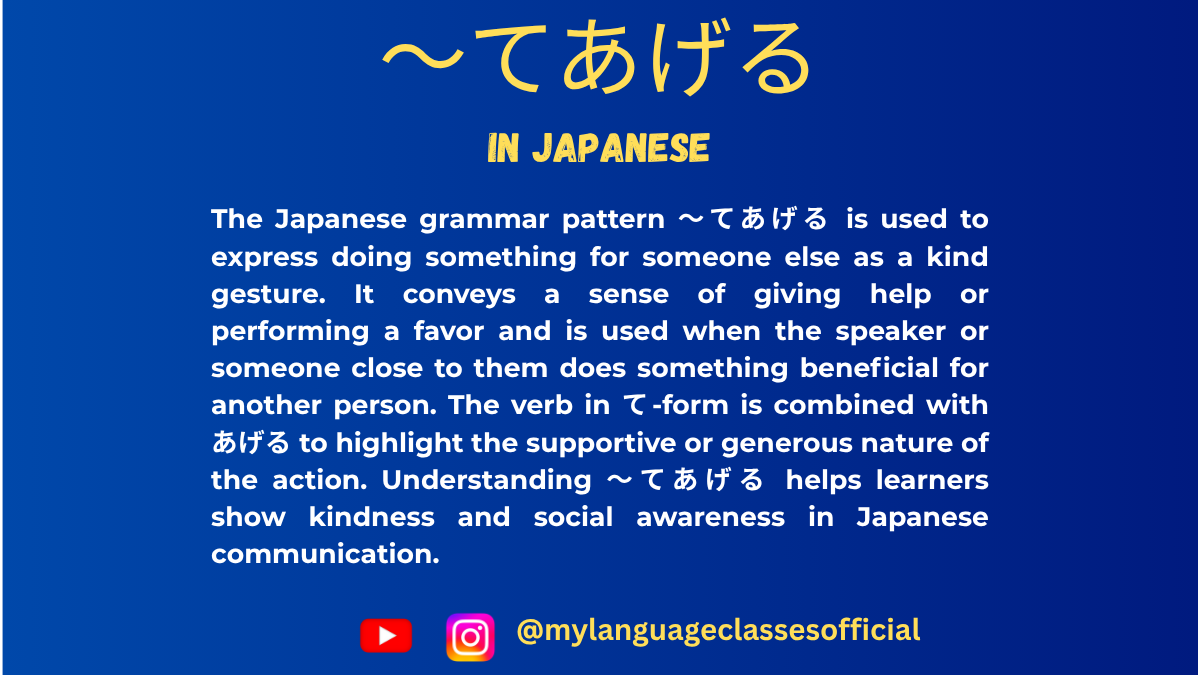
How to Use 〜てあげる | My Language Classes
〜てあげる: To Give (an Action) in Japanese
When learning Japanese, you will often encounter the phrase 〜てあげる (te ageru), which means “to give (an action).” This phrase is used when the speaker or someone performs a beneficial action for another person. The nuance of 〜てあげる is that the action is done out of kindness or generosity.
How to Use 〜てあげる
The structure is simple:
[Person] は [Recipient] に [Action in 〜て-form] + あげる
Example:
- わたしは ともだち に 本を 貸してあげました。
(Watashi wa tomodachi ni hon o kashite agemashita.)
→ I lent a book to my friend (as a favor).
Different Forms of 〜てあげる
The verb あげる can be conjugated into different forms to match the politeness level:
Form Usage 〜てあげる Casual/plain form 〜てあげます Polite form 〜てあげて Te-form for requests 〜てあげない Negative form (not doing the action) 〜てあげなかった Past negative form Situations Where 〜てあげる Is Used
1. Doing Something Nice for Someone Else
- わたしは ちょうとせんせい に にもつを 持ってあげました。
(Watashi wa chouto sensei ni nimotsu o motte agemashita.)
→ I carried the teacher’s luggage for them.
2. Helping Someone
- おとうさんは ぼくに 自転車の修理を してあげた。
(Otousan wa boku ni jitensha no shuuri o shite ageta.)
→ Dad fixed my bicycle for me.
3. Giving Advice or Instruction
- わたしは ともだち に 日本語 を 教えてあげる。
(Watashi wa tomodachi ni nihongo o oshiete ageru.)
→ I will teach my friend Japanese.
4. Buying Something for Someone
- おかあさんは いもうと に 花を 買ってあげました。
(Okaasan wa imouto ni hana o katte agemashita.)
→ Mom bought flowers for my little sister.
5. Making a Favorable Gesture
- 私は 友達 に コーヒーを 作ってあげました。
(Watashi wa tomodachi ni koohii o tsukutte agemashita.)
→ I made coffee for my friend.
6. Expressing Kindness in a Relationship
- けんたろうは かのじょに マッサージを かいてあげた。
(Kentaro wa kanojo ni massaaji o kaite ageta.)
→ Kentaro gave his girlfriend a massage.
7. Helping Children or Animals
- おねえさんは 犬 に 食べ物 を あげてあげた。
(Oneesan wa inu ni tabemono o agete ageta.)
→ The older sister gave food to the dog.
Things to Remember About 〜てあげる
- Used when the action is beneficial: You should only use 〜てあげる when the action is helpful or kind.
- Do not use for superiors: Avoid using 〜てあげる when speaking about actions for a superior (e.g., boss, teacher) as it may sound rude. Instead, use 〜てさしあげる.
- Casual tone: This phrase is often used in informal or everyday conversations rather than in formal writing.
Summary Table: When to Use 〜てあげる
Situation Example Helping a friend はさみを 買ってあげた。 (Bought scissors for them.) Teaching someone えいご を 教えてあげる。 (Teach English to them.) Doing a favor 部屋を 掃除してあげる。 (Clean the room for them.) Helping animals 犬 に 飯 を あげてあげる。 (Give food to a dog.) By mastering 〜てあげる, you can express kindness and generosity in Japanese naturally! Practice using it in real conversations to make your speech sound more fluent and native-like.
Do you have any questions about 〜てあげる? Let me know in the comments!
If you enjoyed this lesson, be sure to check out more posts like this on my blog at My Language Classes. Don’t forget to subscribe my YouTube channel and follow me on Instagram for the latest language learning tips and lessons. Leave a comment below to share your thoughts, or ask any questions you have about nouns.
Happy learning! 😊
- わたしは ともだち に 本を 貸してあげました。
-
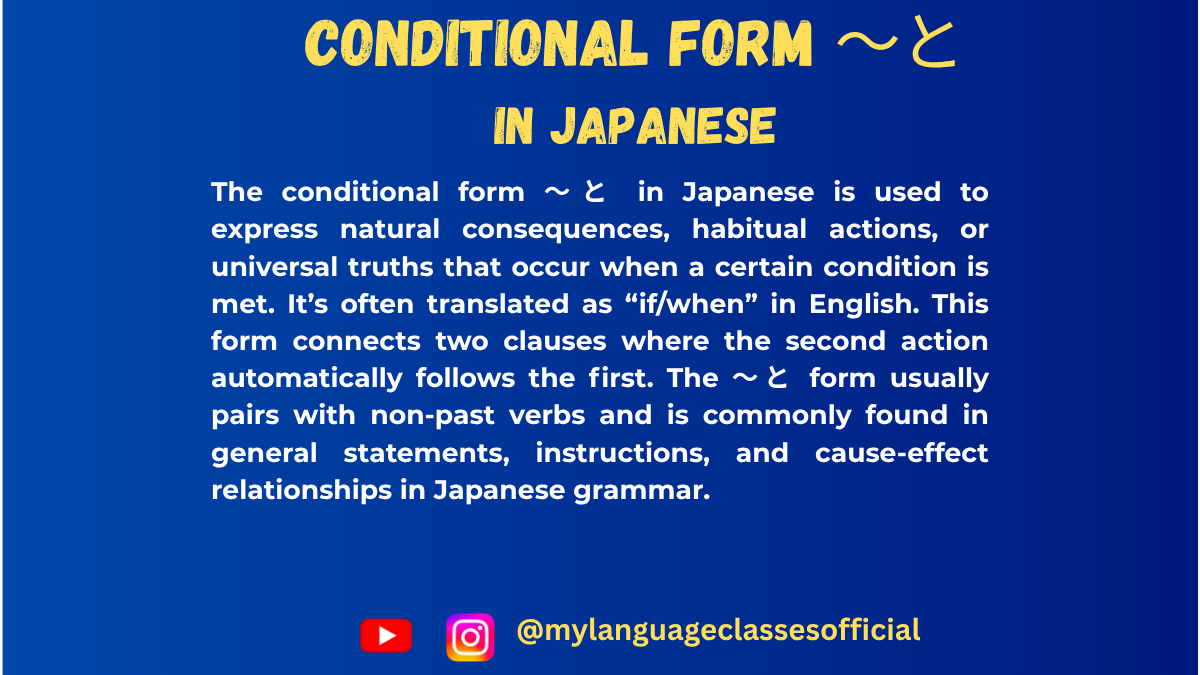
Using 〜と for Natural Consequence | My Language Classes
Expressing a Natural Consequence in Japanese: 〜と
In Japanese, the particle 〜と has a variety of usages, but it is commonly employed to express natural consequences, conditions, or outcomes. Understanding 〜と is essential for mastering conditional sentences and making logical connections between actions or states.
This blog post will explore the various situations where 〜と is used, providing detailed explanations and examples to help you grasp its nuances.
Primary Uses of 〜と
- Expressing a Natural or Inevitable Consequence When 〜と is used, it implies that the result is a natural or automatic outcome of the preceding action or condition. This is particularly common in scientific or logical statements.Structure:
- Clause A と Clause B
(When Clause A happens, Clause B naturally follows.)
- ボタンを押すと、ドアが開きます。
(When you press the button, the door opens.) - 冬になると、雪が降ります。
(When it becomes winter, it snows.)
- Clause A と Clause B
- Habitual Actions or Repeated Outcomes
〜と can describe a habitual action or repeated phenomenon triggered by a condition.Examples:- 朝起きると、コーヒーを飲みます。
(When I wake up in the morning, I drink coffee.) - 毎回この歌を聞くと、昔を思い出します。
(Every time I hear this song, I remember the past.)
- 朝起きると、コーヒーを飲みます。
- Discoveries or Unexpected Realizations
〜と is used to describe a situation where the speaker discovers something upon performing an action.Examples:- ドアを開けると、猫がいました。
(When I opened the door, there was a cat.) - 山の頂上に着くと、美しい景色が広がっていました。
(When I reached the mountain summit, a beautiful view spread out before me.)
- ドアを開けると、猫がいました。
- Warnings and Hypothetical Negative Outcomes
〜と can express a warning or a negative consequence if a certain action is performed.Examples:- 急がないと、電車に乗り遅れますよ。
(If you don’t hurry, you’ll miss the train.) - そんなことをすると、後で後悔しますよ。
(If you do such a thing, you’ll regret it later.)
- 急がないと、電車に乗り遅れますよ。
- Instructions or Rules in Conditional Situations
In formal contexts, 〜と is used to convey instructions, rules, or expected outcomes.Examples:- お金を入れると、商品が出てきます。
(When you insert money, the product comes out.) - このボタンを押すと、エンジンがスタートします。
(When you press this button, the engine starts.)
- お金を入れると、商品が出てきます。
Key Differences Between 〜と and Other Conditional Particles
- 〜と vs 〜ば
While both can describe conditions, 〜ば focuses more on hypothetical or general conditions, whereas 〜と emphasizes a natural or inevitable result.
Example:- 〜と: 雨が降ると、道が濡れます。
(When it rains, the roads get wet.) - 〜ば: 雨が降れば、試合は中止になるでしょう。
(If it rains, the match will likely be canceled.)
- 〜と: 雨が降ると、道が濡れます。
- 〜と vs 〜たら
〜たら is often used for one-time conditions or events and can handle past-tense conditions, unlike 〜と.
Example:- 〜と: 春になると、桜が咲きます。
(When it becomes spring, cherry blossoms bloom.) - 〜たら: 春になったら、旅行に行きたいです。
(When it becomes spring, I want to travel.)
- 〜と: 春になると、桜が咲きます。
List of Situations Where 〜と Is Used
- Natural or inevitable consequences.
- Habitual actions or consistent outcomes.
- Discoveries or unexpected realizations.
- Warnings or hypothetical negative outcomes.
- Instructions, rules, or predictable results in formal contexts.
Points to Remember About 〜と
- Non-Intentional Clause B:
The second clause (Clause B) must describe something out of the speaker’s control, such as a fact, habitual action, or natural consequence. - No Past-Tense Clause A:
The first clause (Clause A) cannot be in the past tense.
Example:- Incorrect: 彼が来たと、部屋が明るくなった。
- Correct: 彼が来ると、部屋が明るくなった。
(When he comes, the room becomes brighter.)
- Clear Cause-and-Effect Relationship:
There must be a logical and automatic relationship between Clause A and Clause B.
Mastering 〜と will enhance your ability to create logical, fluent sentences in Japanese. By understanding its nuances and contexts, you’ll find it easier to express cause-and-effect relationships and describe habitual or natural outcomes in daily conversation and writing.
If you enjoyed this lesson, be sure to check out more posts like this on my blog at My Language Classes. Don’t forget to subscribe my YouTube channel and follow me on Instagram for the latest language learning tips and lessons. Leave a comment below to share your thoughts, or ask any questions you have about nouns.
Happy learning! 😊
- Expressing a Natural or Inevitable Consequence When 〜と is used, it implies that the result is a natural or automatic outcome of the preceding action or condition. This is particularly common in scientific or logical statements.Structure:
-
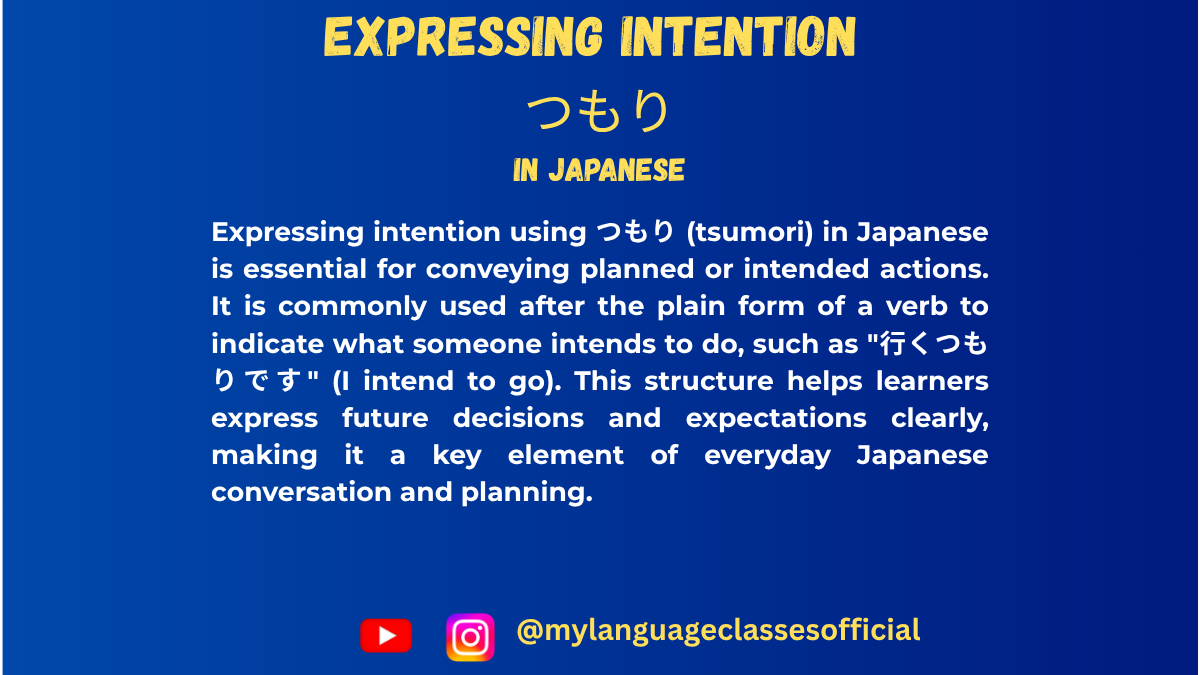
Expressing Intention in Japanese:つもり| My Language Classes
How to Show Intention in Japanese
When learning Japanese, understanding how to articulate intentions or plans is crucial. One of the most common and versatile expressions for this purpose is 〜つもり (tsumori). This post explores the usage of 〜つもり, its nuances, and the various situations where it can be employed.
What is 〜つもり?
〜つもり is a grammatical structure used to express one’s intention, determination, or a plan to do something. It can also convey assumptions or beliefs in certain contexts. The term “tsumori” itself translates to “intention” or “plan.”
The construction is relatively simple:
[Verb in dictionary form] + つもりです – Intend to do something.
[Verb in nai-form] + つもりです – Intend not to do something.
How to Use 〜つもり?
1. Expressing Future Intentions
You can use 〜つもり to clearly state your plans for the future:
- 私は明日学校に行くつもりです。 – I intend to go to school tomorrow.
- 私は歌をうたわないつもりです。 – I intend not to sing a song.
2. Talking About Assumptions
〜つもり can also indicate a belief or assumption about a situation, often with an implied contrast to reality:
- 私は深く理解しているつもりでした。しかし…。 – I thought I understood it deeply, but…
This usage typically involves a past-tense verb and often reflects a misunderstanding.
3. Expressing Unintentional Actions
Although rare, 〜つもり is used to deny responsibility when you didn’t intentionally perform an action:
- それを言うつもりはなかった。 – I didn’t mean to say that.
Politeness Levels
〜つもりです is a polite expression suitable for formal and semi-formal settings. In casual conversations, you can drop です:
- 明日行くつもり。 – I plan to go tomorrow.
Adding 「つもりだよ」 or 「つもりだけど」 softens the tone even further.
Key Situations for Using 〜つもり
Here’s a comprehensive list of contexts where 〜つもり is commonly used:
- Future Plans:
- 私は明日山に行くつもりです。 – I intend to go to the mountains tomorrow.
- Negating Intentions:
- 今年は流行の服を買わないつもりです。 – I don’t plan to buy trendy clothes this year.
- Explaining Changes in Plans:
- 行くつもりだったけど、天気が悪くなりました。 – I intended to go, but the weather turned bad.
- Making Assumptions:
- 自分は結婚しないつもりでしたが…。 – I assumed I wouldn’t get married, but…
- Unintentional Actions:
- あなたを傷つけるつもりはありません。 – I didn’t intend to hurt you.
- Future Determination:
- もっと勉強するつもりです。 – I am determined to study harder.
Common Mistakes to Avoid
- Misinterpreting 〜つもり as a Promise: While 〜つもり expresses intention, it doesn’t guarantee that the action will happen. Avoid confusing it with words like やくそく (yakusoku – promise).
- Using 〜つもり in Commands or Requests: 〜つもり cannot be used to make requests or issue commands.
- Overusing in Formal Writing: In highly formal contexts, more precise expressions like 計画しています (“I am planning”) may be more appropriate.
Practice Examples
Try constructing sentences using 〜つもり in different situations. For instance:
- 私は今年日本語を終わらせるつもりです。
- 私はその話を聞いたつもりですが…
By practicing various scenarios, you’ll gain confidence in using this versatile expression.
Understanding 〜つもり is a valuable step in mastering Japanese. It allows you to articulate intentions, beliefs, and assumptions effectively. Whether planning a trip, expressing a future goal, or clarifying misunderstandings, this structure adds depth to your language skills. Happy studying!
If you enjoyed this lesson, be sure to check out more posts like this on my blog at My Language Classes. Don’t forget to subscribe my YouTube channel and follow me on Instagram for the latest language learning tips and lessons. Leave a comment below to share your thoughts, or ask any questions you have about nouns.
Happy learning! 😊
-

How to Use かもしれない | My Language Classes
Expressing Possibility in Japanese: かもしれない
When learning Japanese, understanding how to express possibility or uncertainty is essential for nuanced communication. The phrase かもしれない (かも) is a versatile and frequently used expression in Japanese to indicate that something “might” happen or “could” be the case. In this blog post, we will delve deeply into the usage of かもしれない, including its grammatical structure, variations, and common situations where it is used.
What Does かもしれない Mean?
かもしれない literally translates to “might” or “could,” expressing a sense of possibility or uncertainty about a situation. It is often used when the speaker is unsure about the likelihood of an event or fact but wants to acknowledge its potentiality.
Variations in Formality:
- Casual: かもしれない
- Polite: かもしれません
- Abbreviated (Casual Speech): かも
- Example: これは大変かも。 (This could be serious.)
Grammatical Structure
かもしれない follows directly after a predicate and can attach to various parts of speech:
- Nouns:
- Structure: [Noun] + かもしれない
- Example: これはプレゼントかもしれない。 (This might be a present.)
- Adjectives (i-adjectives):
- Structure: [i-adjective] + かもしれない
- Example: あの店は高いかもしれない。 (That shop might be expensive.)
- Adjectives (na-adjectives):
- Structure: [na-adjective] + だ + かもしれない
- Example: この話は大事だかもしれない。 (This story might be important.)
- Verbs:
- Structure: [Verb (plain form)] + かもしれない
- Example: かれは来るかもしれない。 (He might come.)
Key Points to Remember
- Degree of Possibility: かもしれない implies a low to moderate degree of certainty. It’s not used for highly probable events.
- Uncertainty Tone: This expression adds a soft, non-committal tone to statements, making it useful in conversations where certainty is lacking.
- Position in Sentence:
- Always follows the predicate directly.
- Cannot be used at the start of a sentence.
- Politeness: Use かもしれません in formal situations or when speaking to superiors.
Common Situations to Use かもしれない
Here are some typical scenarios where かもしれない is used:
1. Guessing About Someone’s Actions:
- 他は明日会社に来ないかもしれない。
(He might not come to the office tomorrow.)
2. Weather Predictions:
- 今夜は雨が降るかもしれない。
(It might rain tonight.)
3. Speculating About the Past:
- 他はこのテストに落ちたかもしれない。
(He might have failed this test.)
4. Expressing Caution:
- その道は危ないかもしれない。
(That path might be dangerous.)
5. Making Suggestions With Hesitation:
- これを使ったら良い結果がでるかもしれない。
(Using this might give good results.)
6. Talking About Plans:
- 私は今年日本へ行くかもしれない。
(I might go to Japan this year.)
7. Health Concerns:
- あなたは病気になりかけているかもしれない。
(You might be getting sick.)
Practical Notes on Usage
- Avoid Overuse: While かもしれない is useful, overusing it can make your statements seem overly speculative.
- Alternative Phrases:
- Instead of かもしれない, consider using 可能性がある (かのうせいがある, “there is a possibility”) for more formal contexts.
- Context Matters:
- Use かもしれない sparingly in professional or serious settings where certainty is preferred.
Practice Exercise
Complete the following sentences with かもしれない:
- 今日はカラオケが出る…。
(It might snow today.) - あの人はこの仕事をキャンセルする…。
(That person might cancel this task.) - この商品は新品じゃない…。
(This product might not be new.)
Conclusion
かもしれない is a subtle yet powerful expression for conveying possibility and uncertainty in Japanese. By mastering its usage, you can add nuance to your conversations and sound more natural when speaking Japanese. Practice using it in different scenarios, and you’ll find it becoming a natural part of your language toolbox!
If you enjoyed this lesson, be sure to check out more posts like this on my blog at My Language Classes. Don’t forget to subscribe my YouTube channel and follow me on Instagram for the latest language learning tips and lessons. Leave a comment below to share your thoughts, or ask any questions you have about nouns.
Happy learning! 😊
-

Understanding 〜でしょう/だろう in Japanese | My Language Classes
Expressions used to indicate probability, conjecture, or seeking confirmation
If you’re diving into the world of Japanese grammar, the particle でしょう (deshou) is one you’ll encounter frequently. It’s a versatile expression that conveys probability, speculation, or seeks confirmation. In this blog post, we’ll explore all the nuances of でしょう, its various uses, and how it interacts with other elements of the language.
1. What is でしょう?
でしょう is the polite form of だろう, which itself is derived from the copula だ (used to state facts). Depending on the context and tone, it can mean:
- “Probably”
- “I suppose”
- “Right?” (as a tag question seeking agreement)
- “It seems that”
Forming でしょう
- Nouns/Na-adjectives:
Add でしょう after the plain form.
Example:
学生 でしょう。 (It’s probably a student.) - I-adjectives:
Attach directly to the base form.
Example:
暑い でしょう。 (It’s probably hot.) - Verbs:
Attach to the plain form.
Example:
行く でしょう。 (He/she/they will probably go.)
2. Expressing Probability
One of the most common uses of でしょう is to express probability or likelihood. It’s often used when the speaker wants to indicate that something is likely true based on their knowledge or perception.
Examples:
- 明日は雨が降る でしょう。
(It will probably rain tomorrow.) - あの映画は面白い でしょう。
(That movie is probably interesting.)
In these cases, でしょう is equivalent to saying “probably” or “I think” in English. It softens the statement, showing that the speaker is not asserting something as a definite fact.
3. Asking for Confirmation
When used with a rising intonation, でしょう turns into a tag question, seeking agreement or confirmation from the listener. It can be translated as “right?” or “isn’t it?” in English.
Examples:
- このケーキ、美味しい でしょう?
(This cake is delicious, isn’t it?) - 彼は先生 でしょう?
(He’s a teacher, right?)
The rising tone at the end signals the speaker is looking for confirmation or agreement.
4. Making Guesses or Predictions
You’ll often hear でしょう in weather forecasts, news reports, or any context where predictions are made.
Examples:
- 明日の天気は晴れ でしょう。
(Tomorrow’s weather will probably be sunny.) - この問題は簡単 でしょう。
(This problem is probably easy.)
In such cases, the speaker uses でしょう to make a statement that isn’t 100% certain but is backed by reasonable evidence or context.
5. でしょう in Casual Speech: だろう
In informal situations, だろう is often used instead of でしょう, especially by men. While だろう serves the same functions, it feels less polite and more casual.
Examples:
- あれは本物のダイヤモンド だろう。
(That’s probably a real diamond.) - 今日は忙しい だろう?
(You’re busy today, right?)
6. Negative Forms
The negative equivalent of でしょう is formed by negating the predicate or verb.
Examples:
- あのレストランは高くない でしょう。
(That restaurant is probably not expensive.) - 彼は来ない でしょう。
(He probably won’t come.)
7. Using でしょう in Hypothetical or Conditional Contexts
When paired with the conditional たら or similar structures, でしょう can express speculation about hypothetical situations.
Examples:
- あの店に行ったら、何か美味しいものがある でしょう。
(If we go to that store, there will probably be something delicious.) - もっと勉強したら、試験に合格する でしょう。
(If you study more, you will probably pass the exam.)
8. Cultural Nuances and Subtleties
In Japanese communication, でしょう plays a role in maintaining politeness and avoiding direct assertions. By using でしょう, the speaker softens their statements, allowing room for the listener’s interpretation or input. This aligns with Japanese cultural norms that emphasize indirectness and respect for others’ perspectives.
For example:
- 今日は寒いです。 (It’s cold today.)
→ Direct and factual. - 今日は寒いでしょう。 (It’s probably cold today.)
→ Politer, leaving room for the listener’s agreement or alternative opinion.
9. Common Pitfalls and Misunderstandings
- でしょう vs かもしれない:
Both express uncertainty, but かもしれない conveys a lower degree of certainty compared to でしょう.
Example:
彼は来る でしょう。 (He will probably come.)
彼は来る かもしれない。 (He might come.) - Overuse in Confirmation Questions:
While でしょう is great for seeking agreement, overusing it can make your speech sound repetitive. Balance it with other expressions like よね or ね for variety.
10. Final Notes
Mastering でしょう allows you to add nuance to your Japanese and navigate conversations more smoothly. It’s a fantastic tool for expressing uncertainty politely, making predictions, or asking for confirmation. Remember:
- Use でしょう for polite speech and だろう for casual contexts.
- Pay attention to intonation when seeking confirmation.
- Practice with real-life scenarios to internalize its subtleties.
Do you have any questions about でしょう or other Japanese grammar points? Share them in the comments below, and let’s learn together! 😊
If you enjoyed this lesson, be sure to check out more posts like this on my blog at My Language Classes. Don’t forget to subscribe my YouTube channel and follow me on Instagram for the latest language learning tips and lessons. Leave a comment below to share your thoughts, or ask any questions you have about nouns.
Happy learning! 😊

